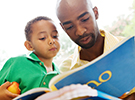How Big is a Foot?
In this lesson, children will use butcher paper to trace their bodies and measure their height and width with their feet.
Lesson for:
Toddlers/Preschoolers
(See Step 5: Adapt lesson for toddlers or preschoolers.)
Content Area:
Data Analysis and Probability
Measurement
Learning Goals:
This lesson will help toddlers and preschoolers meet the following educational standards:
- Understand measurable attributes of objects and the units, systems and processes of measurement
- Apply appropriate techniques, tools and formulas to determine measurement
- Formulate questions that can be addressed with data and collect, organize and display relevant data to answer these questions
- Develop and evaluate inferences and predictions that are based on data
Learning Targets:
After this lesson, toddlers and preschoolers should be more proficient at:
- Recognizing the attributes of length, volume, weight, area and time
- Understanding how to measure, using nonstandard and standard units
- Selecting an appropriate unit and tool for the attribute being measured
- Measuring with multiple copies of units of the same size, such as paper clips laid end to end
- Using tools to measure
- Posing questions and gathering data about themselves and their surroundings
- Representing data using concrete objects, pictures and graphs
- Discussing events related to students’ experiences as likely or unlikely

How Big is a Foot?
Lesson plan for toddlers/preschoolers
Step 1: Gather materials.
- A roll of butcher paper
- Markers or crayons
- The book, How Big is A Foot? by Rolf Myller
Note: Small parts pose a choking hazard and are not appropriate for children age five or under. Be sure to choose lesson materials that meet safety requirements.
Step 2: Introduce activity.
- Ask the children to look at their feet. Explain that they will be using their feet to measure their height and width.
- Explain to the children that you are going to read a book about measurement. Explain that the book is about a king who thinks of a lovely present to give to his wife, the queen. But there is a problem with the present. Explain to the children that they will need to figure out what the problem is and predict what will happen with the king and his gift to the queen.
- Read the book, How Big Is A Foot? Stop at the page where this question is asked: “Why was the bed too small for the queen?”
- Finish the story and discuss how the problem was solved.
Step 3: Engage children in lesson activities.
- Explain that the children are going to use their own feet to measure their width and height and decide on a measurement for their own beds.
- Using the butcher paper, have the children trace each other’s bodies onto the paper. Then cut a rectangle (the bed) around the body outline. The children can then decorate their body tracings and beds.
- First, ask the children to use their own feet to measure the width of their body tracings. Then ask them to measure the height of their body tracings. Write down their findings on a piece of paper.
Additional Extensions
- Give the children rulers and let them use rulers to measure the width and length of their bodies.
- Have the children predict how many feet wide they are and how many feet long they are.
Step 4: Vocabulary.
- Measure: Use of standard units to find out size or quantity in regard to length, breadth, height, area, mass, weight, volume, capacity, temperature and time (e.g.,”Let’s measure the width of your bed.”)
- Width: The extent from side to side or breadth (e.g., “Measure the width of the bed.”)
- Height: The measurement from top to bottom (e.g.,”Today we are going to measure the height of our beds.”)
- Small: Decreased in size (e.g.,”The Queen’s bed is small.”)
Step 5: Adapt lesson for toddlers or preschoolers.
Adapt Lesson for Toddlers
Toddlers may:
- Have difficulty measuring with their own feet
- Have difficulty grasping the idea of measuring a bed for their body tracings to lie on
Child care providers may:
- Trace and cut out multiple copies of the children’s feet so that they can line them up, one in front of the other, and keep better track of how many feet it takes to measure the width and length of the bed needed
- Have the children measure themselves. “I am ________ feet high and ________ feet wide.”
Adapt Lesson for Preschoolers
Preschoolers may:
- Be able to easily use their feet to measure the length and the width of the bed
- Easily calculate and measure the length and the width of the bed
Child care providers may:
- Give the children rulers and let them use the rulers to measure the width and length of their bodies
- Have the children predict how many feet wide they are and how many feet long they are
Suggested Books
- How Big is a Foot by Rolf Myller (New York: Random House Children’s Books, 1991)
- Tall and Small: A Book about Height by Kate Gilbert Phifer (New York: Walker & Co., 1987)
- Length by Henry Arthur Pluckrose (Chicago, IL: Children’s Press, 1995)
- Size by Henry Arthur Pluckrose (Chicago, IL: Children’s Press, 1995)
Music and Movement
Outdoor Connections
Tell the children to measure the perimeter of an outdoor area using their feet. You can also use chalk to draw rectangles and squares on the pavement and ask the children to measure these shapes or measure the squares on the sidewalk.
Comment on this lesson